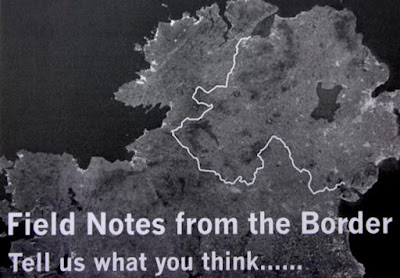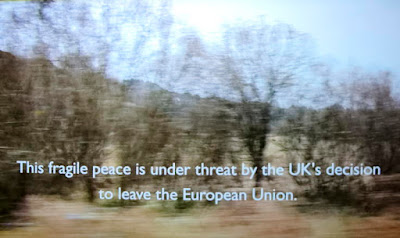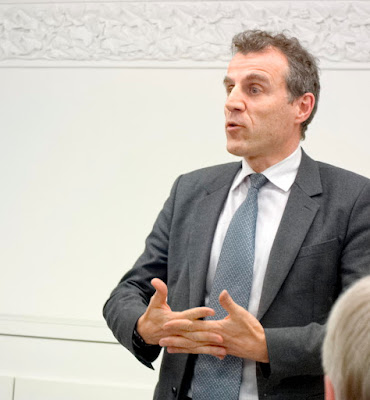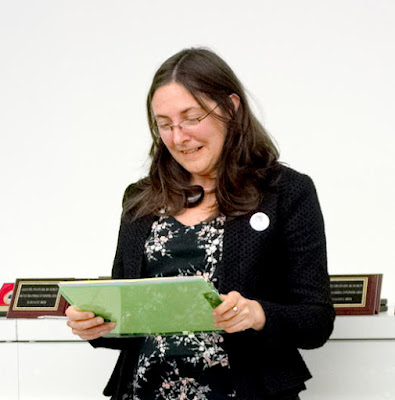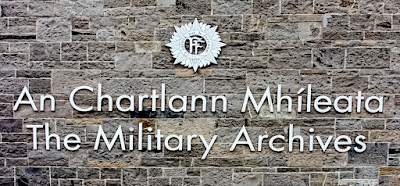Friday, March 29, 2019
FIELD NOTES FROM THE BORDER #1
I had a little time to kill yesterday around the Eustace Street area, so I popped in to Meeting House Square to check out the Gallery of Photography's latest exhibition. It's theme is the border with Northern Ireland, and though it has three contributing artists I had only time to quickly check out that of Anthony Haughey who occupies the main space. This alone made the visit worthwhile.
I think this exhibition must be the least cluttered I've ever been at, and it is all the better for it. The sparseness adds an intensity to the exhibits, particularly appropriate with a subject as emotional as the Border and in the current circumstances of an attempted Brexit.
Still photos included this Burnt-Out Bar, Armagh which took a while to sink in.
And this broken bridge across a river.
The general impression was of a border which, despite its violent past, was steadily withering away.
But, even if you could no longer see it, it was there and in some cases had to be taken into account. For example, in this video, the cyclists from the Direct Provision Centre in Monaghan could roam free in the countryside but dare not cross the border.
As the soothing and envigorating scenery is silently penetrated by the cyclist, it is punctuated with an uneasy feeling of what may lie ahead.
I was only too happy to fill out the card shown at the top of this post.
Check out an Irish Times Review of the exhibition, which lasts until 7 April 2019. A further version #2 opens in Letterkenny today (29 March 2019).
Sunday, March 24, 2019
THE FRENCH PROTOCOL
In 1978/9 Ireland joined the European Monetary System and its component the Exchange Rate Mechanism. This involved pegging the Irish Punt to a central European rate of exchange but within certain margins of fluctuation.
This was a big move for Ireland. Apart from imposing a currency discipline which could be costly to the country, it also involved breaking the traditional parity link with sterling as the UK had opted not to join the system at that point.
At EU level, Ireland negotiated a compensation package involving grants, and subsidies on the interest rates on loans from the European Investment Bank (EIB). At the time, drawing down these subsidies was not a problem as we were borrowing heavily from the EIB in any case. The subsidies came from the EU budget and we succeed in capitalising them, allowing us to draw them down in full at the commencement of each loan. This only proved a problem in later years when the State was rationalising (and fully automating) its loan portfolio. But that is another story.
This centralised EU assistance was augmented by some bilateral arrangements negotiated in the course of a tour of capitals by the relevant officer in the Department of Finance.
One of his major achievements was to negotiate a concessionary financing package with the French. This involved a combination of French State and Development Agency loans. The State loans were, if I remember correctly, at about 4%, way below commercial rates at the time, while the balance was at commercial rates. The package was split 40% State and 60% Agency. The net effect of the combined package was a significant subsidy. The principal condition attaching to the loans was that they be spent on additional French goods. The additional bit meant that an order for Dauphin helicopters could not be used to draw down the loans as that order was already in the pipeline.
Anyway the officer concerned was complimented all round on his negotiating skills and on screwing concessional funding out of the parsimonious French. The arrangement became known as the French Protocol. I would not be surprised to see mention of it on the officer's tombstone.
It was many years later, when I was in the section and pursuing purchase of French goods that the French man I was dealing with suggested that the French themselves could provide financing for the purchases. And out of his back pocket he produced a suggested financing arrangement. The French Protocol to a T. Apparently, it was a standard financing arrangement offered by the French to all and sundry. So much for our great EMS coup.
But, deflated and all as we felt, this was not the end of the story.
It subsequently emerged that, contrary to the conditions envisaged under our French Protocol, we had only been drawing down the 4% State loans and had not drawn down any at commercial rates. However, as we were approaching the end of the period and it would have been difficult for both sides to organise a flurry of loans at commercial rates and find relevant purchases to draw them down, it was decided to call time on the French Protocol.
And the moral of the story?
He who laughs last, laughs longest.
Saturday, March 23, 2019
JOUTES ORATOIRES 2018/19
Having been at last year's debate I was keen not not to miss it this year.
My interest stems from my own participation in inter-schools debates in a second language (Irish) and from my general interest in what the French modestly refer to as Langue et Civilisation Française. I have had on-off contact with this culture for some fifty years, have given a talk in French at the Alliance and have another, in English this time, in the oven, though it is unlikely to see the light of day at this late stage.
This years audience, apart from being packed out with parents of the lads and lasses who took part in this year's competition, and particularly those who made it to the final, also included some heavy hitters, such as Pat Cox and the French Ambassador, Stéphane Crouzat. As it turned out they were to prove more than mere spectators as you'll see below.
The Alliance Director kicked off by welcoming all to the joust. He was clearly proud of this particular branch of the Alliance's activities. Some 40 schools from around the country participated in this year's competition and there were more applications than could be accommodated.
I learned at a book launch here just over a year ago that the French education system puts a premium on teaching pupils to present themselves well in the world. They should at all times, and irrespective of the circumstances, be able to project the confidence of a winner.
Impressions count for a lot and in his speech, where he praised the work of the Alliance in general, and of this competition in particular, the Ambassador gave us a masterclass in projection.
Now, I know the French wave their arms around a lot and the Ambassador, himself an Énarque, is a winner. Nevertheless, I thought you might enjoy his performance as encapsulated in these few images.
Pat, whose talents are more verbal than gesticular, is the Président (Chairman) of the Alliance, and proud he is of it. I think he said it was the largest Alliance in a non-French-speaking country. In fact, the Dublin Alliance Française is the world's third-largest Alliance, behind only those in francophone Paris and Brussels.
The Reverend Chairman of the Joutes Steering Committee gave us a quick run down on the competition and its rules .
Les Joutes Oratoires Interscolaires, créées au début des années 1990 dans le cadre de l’Alliance française de Dublin, ont pour but de donner aux élèves une plus grande assurance, de les préparer à l’oral du Leaving Cert, et de dynamiser les cours de français. En effet, depuis leur fondation, plus de trois mille élèves ont participé aux Joutes. L’idée de base est simple: il s’agit de permettre à des élèves de français de Transition Year, Fifth Year au Sixth year, issus d’établissements différents, en République d’Irlande mais aussi en Irlande du Nord, de se rencontrer pour débattre, en français, sur des sujets extrêmement divers.and we're off.
À chaque fois, deux équipes de quatre membres défendent un point de vue opposé sur une question particulière. Chaque membre d’une équipe développe un argument particulier et peut être interrompu à tout moment par l’équipe adverse. À l’issue du débat, chaque capitaine résume les arguments développés par son équipe et un jury de trois professeurs de français déclare l’une des deux équipes gagnante.
I have outlined a lot of the background to the competition and my own reactions in my blog post on last year's final.
Last year we had two girls' schools debating Free Speech. This year it's two boys' schools debating whether La Parité (equality?) is just a utopian idea or whether it is a realisable objective. This is a potentially vast subject which could cover gender, wealth, minorities of various sorts and so on. And the debate did cover a lot of these, though my impression was that the gender theme tended to dominate.
Belvedere had the task of showing that this was a pipe dream which would never be realised. For this they relied on human nature, the cruel world we live in, and increasing disparities all over the place.
St. Michael's, on the other hand, relied on current progress in a number of areas as indicators of the way the world was moving and they asserted that, on the basis of these trends and sometime in the future, La Parité would become a universal reality, thus challenging Belvedere's case.
Given that the subject and sides were known well in advance, it is no surprise that both sides mustered batteries of statistics and examples in the cause.
It would be difficult to say who won the argument as that answer lies in the future. What counted here was the debate: effectiveness in presentation, robustness of response and resilience in the face of killer heckles.
You must remember that this is all taking place in what is a second language to all the debaters and some of the advantages that one might think of which would subvert a level playing field are actually grounds for disqualification. For example
A team member must
- not be born in a French-speaking country.
- not have a parent/guardian whose mother tongue is French.
- not having lived in a francophone environment for more than 2 years.
- not be a previous winner.
When all was said and done I expected St. Michael's to win, based on their performance aimed at convincing the audience and their resilience under heckle. This was based on an overall feeling on my part and not on any strict marking system.
In the event, when Nathalie-Zoé delivered the verdict on behalf of the jury, the prize went to Belvedere and St. Michael's had to console themselves with their rugby double this year. As Pat put it, Belvedere for debates, St. Michaels for rugby. Or as I might imagine it St. Ignatius Loyola versus The Holy Ghost.
All in all, a good night's entertainment and a hope for future success on the European playing field.
Sunday, March 03, 2019
KEEPERS OF THE FLAME

Cécile Gordon (née Chemin)
Photo: Fiona Morgan/South Wind Blows
Click on any image for a larger version
You will note that the title of this post is in the plural but that there is only one person in the photo. Cécile is the project manager. She is responsible for the ongoing management and the outcome of the project which is still in the course of development.
She would be the first to stress that this project depends ultimately on tight teamwork and a vast network of cooperation across the public service and beyond.
It is an innovative project of epic proportions. So, what the hell is it?
Well, that's what the public symposium in Cathal Brugha Barracks set out to demonstrate to a packed conference room on 23/2/2019. The symposium was structured around the release of the IRA Brigade Activity Reports (BARs) from the War of Independence but these were part of the process of adjudicating pensions applications for "military service" during that war and so they cannot be seen in isolation from the wider picture. The symposium was therefore effectively dealing with the whole project.
The demand for places was high and if you hadn't got your ticket or your name wasn't on the list, you didn't get past the front gate.
This is, after all is said and done, a working barracks. I passed the first test with flying colours and then almost ruined it with an indiscreet piece of photography, but that's another story.
The wider project itself is the cataloguing, digitising, and release online of military pensions applications relating to the revolutionary period 1916-1923. Applications came from those claiming service in the cause or from the relatives of deceased members. Many, if not the majority of claimants had fallen on very hard times and were not impressed by the State's ingratitude in refusing a pension or granting one below the level the claimant thought appropriate, or even needed just to survive.
The records are held in the Military Archives in the barracks. I had been there in another context to check out papers captured from Peggy Medlar in 1923 by Free State Forces but I have yet to visit the spanking new award winning building.
The proximate cause of the symposium was the release of IRA Brigade Activity Reports, covering the whole island during the revolutionary period and forming a magnificent complement to the pensions claims proper. These reports were compiled in the 1930s by committees of former officers of the period and formed an integral element in the adjudication of claims under the 1934 Act.
I should stress that this is a blog post and not intended as a PhD thesis. My purpose here is to convey in broad terms my own enthusiasm for the project and at the same time give some impression of the symposium and some of the individual contributions. If you want a more detailed view you can go to the project online and explore this wonderful resource at your leisure. If you want to hear the full talks of contributors along with the discussion it is now online.
Each participant in the symposium got a marvelous introductory volume which explained the reports and also had serious essays by members of the advisory panel. It is a very good production and is lavishly illustrated. For the moment, I have just skimmed the introduction but look forward to going carefully through it while I am chasing up relatives and persons of interest online.
The context of the wider project is the Government's Decade of Centenaries 1912-22 Commemoration Programme.
Catríona was our MC for the day and no better person. She is no stranger to this blog, and she is clearly very enthusiastic about this project.
She oversaw the contributions with what I can only describe as benign military precision and spiced the process with serious and entertaining interventions of her own.
She made the point a number of times during the day that the project is being implemented to the highest archival standards.
Cécile gave us a rundown on the project itself and rightly took great pride in telling us that:
Ireland will be the first country ever to systematically digitise and database the entire history of its independence movement (including a Civil War), as found in the files and make this material available to all.
Make you proud, it would.
She also reminded us that the first instalment of the pension application files was released in 2014 in time for the 1916 centenary commemorations. She stressed the overall value of the project in allowing us to follow up the post-revolutionary fate of individuals.
The Brigade Activity Reports (BARs) also remind us of the permeable relationship between the individual, familial, local, organisational and wider collective memories.This is an exercise of exploration and fact-checking through many levels.Her initial intervention is not included in the release of the recorded contributions but she went over some of the ground in the course of the later discussion and you can hear this here.
These are personal stories of common men and women caught up in significant events.
Cécile had stressed the importance of the Department of Defence's commitment to release the files, so Paul, the Minister of State at the Department of Defence, could afford to take a bow on the day.
It was clear from his speech that he had a personal interest in the project.
His official function was to launch the release of the current online publications.
Mind you, at one point I thought this "Cecily" person was stealing all the glory from our Cécile until I copped the Minister's gift for simultaneous translation.
The approach of the authorities in releasing these records, with only minimal mandatory redactions, should be acknowledged. I know from what Cécile said that all the material has been carefully read, but, as Fearghal McGarry pointed out, the files do contain some difficult history.
"A brave decision, Minister."
Anne Dolan is Associate Professor of Modern Irish History in TCD. She gave us what both Catriona and Cécile described as a masterclass in analysing the sources.
She took a Brigade Report to identify those men from Collins's Squad who went to a house in Mount Street on the morning of Bloody Sunday (21 November 1920) on an assassination mission. She then used the pension applications and other sources to follow up what happened to them afterwards.
The story was horrific with most of the men suffering what later came to be known as post traumatic stress disorder. I was thinking in the back of my mind that there was probably some connection between this outcome and the brutality of those Free State interrogators, who had been members of the Squad, in the course of the Civil War.
As Catriona commented, Anne had squeezed the sources to death, or something on those lines. It was indeed an absolutely fascinating session and it really showed the power of the new sources, particularly when interrogated in conjunction with other sources.
That session was over all too soon.
You can hear Anne's full contribution here.
Fearghal is Professor of Modern Irish History in Queens.
He structured his talk around his book on the Abbey Theatre Rebels, ie those who participated in the Rising and were also connected with the Abbbey Theatre. Again, like Anne, he was defining a particular group and using the pensions files, along with other sources, to tell or supplement their stories. He made the point that these files are often the only source we have for the activities and emotions of the rank and file of the revolution who were not particularly noticed at the time and who subsequently faded into obscurity and often resentful hard times.
He instances Helena Moloney whose fight for a decent pension was not primarily for the money, though she badly needed that, but to get women's activities recognised as "military action" and thus an equal contribution to the revolution to that of the men and also to carry an entitlement to a pension.
Finally Fearghal touched on the role of memory. What do people remember and how does this square with the facts insofar as these can be determined from other sources. As he says, these files are full of difficult history.
You can hear Fearghal's full contribution here.
Leeanne is a Lecturer in the School of History and Geography in DCU. She was looking at the files as a source for researching women's history in the War of Independence and in the Civil War. She took a number of women, from the 1,450 available female applicants, and in telling their stories drew a series of conclusions on the gendered aspect of what the files revealed.
We have to remember here that women were effectively excluded under 1924 Act which did not include Cumann na mBan as a qualifying organisation and dismissed the nonetheless vital contribution of women, including over range of essential and equally risky support activities, from consideration.
Leeanne paid particular attention to the impact of these women's activities on their subsequent health and even family relationships. Fearghal referred to the files being full of difficult history. Indeed. Leeanne recounts the story of Margaret Doherty during the Civil War when three armed and masked officers of the Free State Army entered her house, terrified the occupants, dragged Margaret away from the house and successively raped her. She ended up in Castlebar mental hospital as a result and never came out.
Then we had Mary McSweeney who refused to engage with the Free State Pensions Board to the point of not even corroborating the applications of other women. I must say that this seems a bit harsh to me, but it does illustrate the divisiveness of the Civil War.
Leeanne's contribution also showed the huge effort by women to justifiably broaden the range of eligible activities.
You can hear Leeanne's full contribution here.
Barry John taught history in Dublin from 2001 to 2016. He got his MA in 2017 and his thesis subject was the administration of the military pensions to Six County veterans under the 1924 Act.
His talk brought to light a whole new perspective on the pensions, not only in relation to some unique problems for administration posed by partition, but in revealing the attitude of many northern veterans to the new state.
From an administration point of view, the difficulties were unanticipated.
Applicants were living outside the jurisdiction in another potentially hostile jurisdiction. Transmission of documentation was problematic. Post addressed to a southern barracks got "special" treatment by the Six County authorities. One man went to jail (post 1934) for possession of such documentation. Hearings were held exclusively south of the border. There was no advertising for claims in the northern newspapers.
Northern claimants felt betrayed and isolated. The success rate of claims was way below the southern average and those denied pensions were held up to ridicule in their local areas.
The period of the 1921/22 truce was held as a period of low activity nationally whereas it was a period of most intensive activity in Belfast. Disregard of pensionable service, based on the southern lull, was a cause of bitterness and resentment for northern veterans and the situation was only rectified under the 1934 Act by the Fianna Fáil government.
This was a really fascinating and unanticipated analysis.
You can hear Barry John's full contribution here.
Donal is a Senior Lecturer in History at University College Cork. He was drawing out the local aspect of the material by looking at the BARs from Cork and Munster.
He gave us an entertaining account of his first contact with the Bureau.
He reminded us that Cork was the storm-centre of revolutionary and counter-revolutionary violence in the War of Independence, which was why he described it as the War Zone in the title of his talk.
He highlighed the many internal difficulties within the movement. He cited, as an example, problems with HQ in supplying arms, where a Tipperary Battalion which was instructed to destroy bridges had to do this with pickaxes for want of explosives from HQ.
He dealt with the grim business of the IRA executing spies, sometimes passed over casually in the BARs. But there is one account of an execution by a North Kerry Flying Column of an ex-RIC officer, then a fisheries inspector and a widower, which includes the condemned man's letter to his children. The letter is reproduced in the volume we got at the beginning and it is a sad read.
Donal gave us some interesting insights into the logistics of the flying columns, for instance, the scale of mobilisation undertaken for attacks on barracks.
He quoted Roy Foster's comment on the influence of paintings on the myths of history and underlined the more prosaic pictures emerging from this archive.
You can hear Donal's full contribution here.
Charlie is a cartographer who, among other things, has worked on the Atlas of the Irish Revolution. He is currently working on the digital version of the Atlas with Donal using material from the pensions collection.
He gave us a dazzling display of geographical interactivity based on the pensions data.
Understandably, he is not in the audio, as without the visuals his contribution would not make sense.
Prior to the discussion we were shown three clips from the film Keepers of the Flame which deals with this particular archive. You can check out the film's Facebook page.
The discussion panel comprised (l-r) Eunan O’Halpin, Cécile Gordon, Nuala O’Connor, Diarmaid Ferriter and Anne Dolan.
The discussion was moderated by Catriona and she started with Nuala, who was co-writer and director of Keepers of the Flame.
Nuala said she wanted to show the real people behind the pension application letters. They were very fortunate to be able to interview some descendants in the original family houses. She was full of praise for her innnovative cameraman even though she nearly had a fit as he crumpled and poured water and dust over the letters to give them an authentic look. Fortunately these were only facsimiles.
Next was Diarmaid, who Catriona said needed no introduction, but I'll let you in on a secret. He's Professor of Modern Irish History in UCD. He stressed that this archival project could be held up internationally on "how to do it". Within the Decade of Centenaries he felt that priority should be given to legacy projects, (ie those which will leave something after them), and this was very much one of those. It was layered history with strong personal elements. But we can handle it 100 years on (including the Civil War). The approach to commemoration needs to be ground up & not top down, though certain major events will need to be commemorated by the State.
Eunan is Professor of Contemporary Irish History at TCD. He made the point that the Six Counties can tend to be ignored in looking at the War of Independence because they subsequently became part of somewhere else. He mentioned the need for an epidemiological analysis of cohorts as between Northern claimants and those in the South. He made a plea for the release of the last major archival source for the period, the Land Commission records. Catriona was quick to jump in and endorse this plea. She said she had been trying to get these released for the last twenty years.
Catriona described Cécile as the second hero of the project, following Pat Brennan, who was the first manager. She was full of congratulations for a project done to the highest archival standards and which gives the researcher everything they want.
Cécile reported that there were 100,000 files processed, heading for 2 million pages scanned. Standard of cataloguing are kept very high. Each file is unique so extended descriptions are vital to subsequently finding the material. An archivist could stay a whole day with one file. There are no redactions unless required under Section 8 of the National Archives Act. These mainly relate to data protection problems for still living people. So there is a need to have read absolutely everything.
You can hear Cécile giving an extended rundown on the project here.
Catriona asked Anne about gaps in the material. Anne couldn't think of any on the spot but felt there must probably be many not yet identified. However, the quality and professionalism of the material will make it robust enough to answer almost any questions future researchers come up with.
You can hear the full conversation with the panel here.
I made two interventions from the floor: the first in response to Anne's talk, and the second following the panel discussion.

(l-r) Vice-Admiral Mark Mellett Óglaigh na hÉireann Chief of Staff, Paul Kehoe, Department of Defence Secretary-General Maurice Quinn, Cécile Gordon
In the final roundup, and in a broad ranging thanks to all her collaborators and those who made the day such a seamless success, Cécile included the OPW and tech teams who had, inter alia, ensured that there were seats for bums (my words) and that we could see and hear everything.
Subscribe to:
Comments (Atom)
